AI and Robotics in Agriculture: A Systematic and Quantitative Review of Research Trends (2015–2025)
Abstract
1. Introduction
2. Materials and Methods
3. Results
3.1. Publication Trends
3.2. Geographic Distribution
3.3. Keyword Co-Occurrence and Thematic Clustering
3.4. AI Techniques Distribution
3.5. Robotic Platform Use
3.6. Crop Types Studied
3.7. Deployment and Implementation Contexts of AI-Robotic Systems
4. Discussion
4.1. Quantified Research Gaps
- Field validation rate: Fewer than 30% of Scopus, WoS, and IEEE studies validate results in real agricultural conditions, despite the large number of simulations and controlled lab studies [27,28,29]. This low rate of testing in real fields makes AI models less trustworthy and harder to apply in unpredictable outdoor settings, where factors like light, weather, and differences in living things can complicate how these systems see and make decisions.
- Adoption of explainable AI (XAI): Deep learning models used in agricultural robotics are becoming more complex and opaquer, but explainable AI has been rarely integrated. Less than 3% of reviewed publications (in Scopus, WoS and IEEE) mention saliency maps, SHAP, and LIME [30,31,32,33]. This lack of transparency impacts trust, regulatory compliance, and user understanding in high-stakes, safety-critical agricultural tasks.
- Coverage by region, crop, and task: The research landscape is still poorly balanced, i.e., the majority of AI-robotics publications come from India, China, and the US, leaving Sub-Saharan Africa, Southeast Asia (excluding China and India), Europe, and parts of Latin America underrepresented. The literature focuses on maize, rice, and wheat, but berries, leafy greens, and tropical fruits are neglected. This imbalance could be attributed to the scarcity of open datasets for horticultural crops, the high variability in plant morphology, and the limited commercial incentives driving large-scale data collection for specialty crops [34,35]. Most studies focus on monitoring and spraying, while harvesting, weeding, and post-harvest sorting are understudied. This imbalance restricts AI generalizability and reinforces agricultural innovation disparities [36].
4.2. Technical Challenges
4.3. Ethical and Socioeconomic Barriers
4.4. Scalability and Infrastructure Limitations
4.5. Research Priorities and Roadmap for Advancing AI-Robotic Agriculture
5. Conclusions
Author Contributions
Funding
Data Availability Statement
Acknowledgments
Conflicts of Interest
Appendix A
| Year | WoS | Scopus | IEEE |
|---|---|---|---|
| 2025 | 269 | 298 | 83 |
| 2024 | 771 | 1173 | 371 |
| 2023 | 540 | 792 | 246 |
| 2022 | 392 | 553 | 117 |
| 2021 | 330 | 975 | 122 |
| 2020 | 214 | 847 | 95 |
| 2019 | 139 | 265 | 78 |
| 2018 | 58 | 59 | 38 |
| 2017 | 31 | 33 | 23 |
| 2016 | 12 | 21 | 9 |
| 2015 | 8 | 13 | 5 |
| Scopus | WoS | |||
|---|---|---|---|---|
| Rank | Country | Publications | Country | Publications |
| 1 | INDIA | 1412 | CHINA | 754 |
| 2 | CHINA | 750 | USA | 604 |
| 3 | UNITED STATES | 707 | INDIA | 256 |
| 4 | UNITED KINGDOM | 208 | UNITED KINGDOM | 158 |
| 5 | ITALY | 205 | GERMANY | 153 |
| 6 | AUSTRALIA | 178 | ITALY | 129 |
| 7 | GERMANY | 167 | AUSTRALIA | 122 |
| 8 | CANADA | 140 | SPAIN | 120 |
| 9 | BRAZIL | 134 | JAPAN | 108 |
| 10 | SAUDI ARABIA | 127 | BRAZIL | 101 |
| 11 | PAKISTAN | 126 | SOUTH KOREA | 98 |
| 12 | SPAIN | 126 | CANADA | 89 |
| 13 | SOUTH KOREA | 125 | SAUDI ARABIA | 83 |
| 14 | JAPAN | 122 | NETHERLANDS | 72 |
| 15 | MALAYSIA | 104 | PAKISTAN | 68 |
| 16 | GREECE | 92 | FRANCE | 66 |
| 17 | FRANCE | 89 | PORTUGAL | 54 |
| 18 | RUSSIAN FEDERATION | 89 | MALAYSIA | 53 |
| 19 | PORTUGAL | 82 | GREECE | 51 |
| 20 | NETHERLANDS | 80 | TAIWAN | 43 |
| 21 | IRAN | 76 | SOUTH AFRICA | 32 |
| 22 | INDONESIA | 75 | FINLAND | 29 |
| 23 | TAIWAN | 75 | RUSSIAN FEDERATION | 29 |
| 24 | TURKEY | 75 | AUSTRIA | 27 |
| 25 | MOROCCO | 59 | COLOMBIA | 27 |
| 26 | VIET NAM | 56 | IRAN | 26 |
| 27 | BANGLADESH | 55 | BELGIUM | 25 |
| 28 | EGYPT | 48 | EGYPT | 25 |
| 29 | SOUTH AFRICA | 47 | IRELAND | 25 |
| 30 | UNITED ARAB EMIRATES | 42 | UNITED ARAB EMIRATES | 25 |
| 31 | IRELAND | 41 | TURKIYE | 23 |
| 32 | THAILAND | 41 | DENMARK | 22 |
| 33 | POLAND | 40 | MEXICO | 21 |
| 34 | COLOMBIA | 39 | SCOTLAND | 21 |
| 35 | ROMANIA | 39 | NORWAY | 20 |
| 36 | MEXICO | 38 | ROMANIA | 20 |
| 37 | FINLAND | 32 | INDONESIA | 19 |
| 38 | AUSTRIA | 31 | POLAND | 19 |
| 39 | IRAQ | 31 | THAILAND | 19 |
| 40 | PHILIPPINES | 28 | ISRAEL | 18 |
| 41 | SRI LANKA | 28 | VIETNAM | 18 |
| 42 | DENMARK | 27 | NEW ZEALAND | 17 |
| 43 | NIGERIA | 27 | BANGLADESH | 16 |
| 44 | BELGIUM | 26 | SWITZERLAND | 16 |
| 45 | SWEDEN | 24 | CZECH REPUBLIC | 15 |
| 46 | TUNISIA | 24 | SINGAPORE | 15 |
| 47 | SINGAPORE | 22 | SWEDEN | 15 |
| 48 | NEW ZEALAND | 21 | CHILE | 14 |
| 49 | HONG KONG | 20 | SERBIA | 14 |
| 50 | ALGERIA | 19 | TUNISIA | 14 |
| 51 | ETHIOPIA | 19 | CROATIA | 13 |
| 52 | NORWAY | 19 | MOROCCO | 13 |
| 53 | HUNGARY | 18 | PHILIPPINES | 13 |
| 54 | ISRAEL | 18 | TURKEY | 13 |
| 55 | SWITZERLAND | 18 | ETHIOPIA | 12 |
| 56 | CZECH REPUBLIC | 17 | LEBANON | 12 |
| 57 | UKRAINE | 17 | IRAQ | 11 |
| 58 | CROATIA | 16 | NIGERIA | 11 |
| 59 | PERU | 16 | HUNGARY | 10 |
| 60 | CHILE | 15 | PERU | 10 |
| 61 | ECUADOR | 14 | QATAR | 10 |
| 62 | QATAR | 14 | ECUADOR | 9 |
| 63 | SERBIA | 14 | SRI LANKA | 9 |
| 64 | JORDAN | 13 | UKRAINE | 8 |
| 65 | LEBANON | 13 | ALGERIA | 7 |
| 66 | BULGARIA | 10 | KAZAKHSTAN | 7 |
| 67 | ESTONIA | 10 | OMAN | 7 |
| 68 | KAZAKHSTAN | 10 | SLOVAKIA | 7 |
| 69 | OMAN | 10 | BULGARIA | 6 |
| 70 | UGANDA | 10 | JORDAN | 6 |
| 71 | ZIMBABWE | 10 | LUXEMBOURG | 6 |
| 72 | BRUNEI DARUSSALAM | 9 | SLOVENIA | 6 |
| 73 | KENYA | 9 | UGANDA | 6 |
| 74 | LATVIA | 9 | ZIMBABWE | 6 |
| 75 | ARGENTINA | 8 | ESTONIA | 5 |
| 76 | CYPRUS | 8 | KENYA | 5 |
| 77 | LUXEMBOURG | 8 | CYPRUS | 4 |
| 78 | RWANDA | 8 | GHANA | 4 |
| 79 | SENEGAL | 8 | RWANDA | 4 |
| 80 | SLOVAKIA | 7 | WALES | 4 |
| 81 | AZERBAIJAN | 6 | YEMEN | 4 |
| 82 | BAHRAIN | 6 | BURKINA FASO | 3 |
| 83 | COSTA RICA | 6 | COTE IVOIRE | 3 |
| 84 | LITHUANIA | 6 | KUWAIT | 3 |
| 85 | SLOVENIA | 6 | LATVIA | 3 |
| 86 | SUDAN | 6 | MALAWI | 3 |
| 87 | TÜRKIYE | 6 | NAMIBIA | 3 |
| 88 | YEMEN | 6 | NEPAL | 3 |
| 89 | MACAO | 5 | UZBEKISTAN | 3 |
| 90 | MYANMAR | 5 | ARGENTINA | 2 |
| 91 | GHANA | 4 | AZERBAIJAN | 2 |
| 92 | UZBEKISTAN | 4 | BENIN | 2 |
| 93 | BOSNIA AND HERZEGOVINA | 3 | CAMEROON | 2 |
| 94 | BURKINA FASO | 3 | DEM REP CONGO | 2 |
| 95 | KYRGYZSTAN | 3 | LITHUANIA | 2 |
| 96 | MALTA | 3 | MONGOLIA | 2 |
| 97 | MONGOLIA | 3 | MYANMAR | 2 |
| 98 | NAMIBIA | 3 | SENEGAL | 2 |
| 99 | NEPAL | 3 | TANZANIA | 2 |
| 100 | TANZANIA | 3 | URUGUAY | 2 |
| 101 | URUGUAY | 3 | ZAMBIA | 2 |
| 102 | BOTSWANA | 2 | AFGHANISTAN | 1 |
| 103 | CUBA | 2 | ARMENIA | 1 |
| 104 | EL SALVADOR | 2 | BOSNIA HERCEG | 1 |
| 105 | FIJI | 2 | BOTSWANA | 1 |
| 106 | MALAWI | 2 | COSTA RICA | 1 |
| 107 | MALI | 2 | EL SALVADOR | 1 |
| 108 | MAURITANIA | 2 | FIJI | 1 |
| 109 | MOZAMBIQUE | 2 | GABON | 1 |
| 110 | NIGER | 2 | GRENADA | 1 |
| 111 | PANAMA | 2 | LAOS | 1 |
| 112 | PAPUA NEW GUINEA | 2 | MALTA | 1 |
| 113 | PARAGUAY | 2 | MAURITANIA | 1 |
| 114 | SIERRA LEONE | 2 | MOLDOVA | 1 |
| 115 | ZAMBIA | 2 | NORTH MACEDONIA | 1 |
| 116 | AFGHANISTAN | 1 | PANAMA | 1 |
| 117 | ARMENIA | 1 | REP CONGO | 1 |
| 118 | BHUTAN | 1 | SIERRA LEONE | 1 |
| 119 | CAMEROON | 1 | SOUTH SUDAN | 1 |
| 120 | COTE D’IVOIRE | 1 | SUDAN | 1 |
| 121 | DEMOCRATIC REPUBLIC CONGO | 1 | ||
| 122 | FRENCH POLYNESIA | 1 | ||
| 123 | GABON | 1 | ||
| 124 | GEORGIA | 1 | ||
| 125 | HONDURAS | 1 | ||
| 126 | ICELAND | 1 | ||
| 127 | KUWAIT | 1 | ||
| 128 | MADAGASCAR | 1 | ||
| 129 | MAURITIUS | 1 | ||
| 130 | MOLDOVA | 1 | ||
| 131 | NORTH KOREA | 1 | ||
| 132 | PALESTINE | 1 | ||
| 133 | SOUTH SUDAN | 1 | ||
| 134 | SYRIAN ARAB REPUBLIC | 1 |
References
- Bezner Kerr, R.; Naess, L.O.; Allen-O’Neil, B.; Totin, E.; Nyantakyi-Frimpong, H.; Risvoll, C.; Rivera Ferre, M.G.; López-i-Gelats, F.; Eriksen, S. Interplays between Changing Biophysical and Social Dynamics under Climate Change: Implications for Limits to Sustainable Adaptation in Food Systems. Glob. Change Biol. 2022, 28, 3580–3604. [Google Scholar] [CrossRef]
- Bisoffi, S.; Ahrné, L.; Aschemann-Witzel, J.; Báldi, A.; Cuhls, K.; DeClerck, F.; Duncan, J.; Hansen, H.O.; Hudson, R.L.; Kohl, J.; et al. COVID-19 and Sustainable Food Systems: What Should We Learn Before the Next Emergency. Front. Sustain. Food Syst. 2021, 5, 650987. [Google Scholar] [CrossRef]
- Alexandratos, N.; Bruinsma, J. World Agriculture Towards 2030/2050: The 2012 Revision; FAO Document Repository, ESA Working Papers 12-03; FAO: Rome, Italy, 2012. [Google Scholar] [CrossRef]
- McKenzie, F.C.; Williams, J. Sustainable Food Production: Constraints, Challenges and Choices by 2050. Food Secur. 2015, 7, 221–233. [Google Scholar] [CrossRef]
- Mohyuddin, G.; Khan, M.A.; Haseeb, A.; Mahpara, S.; Waseem, M.; Saleh, A.M. Evaluation of Machine Learning Approaches for Precision Farming in Smart Agriculture System: A Comprehensive Review. IEEE Access 2024, 12, 60155–60184. [Google Scholar] [CrossRef]
- Warbhe, M.K.; Verma, P.; Rewatkar, R. A Review on the Use of AI and Robotics in Agricultural Practices. In Proceedings of the 2024 Second International Conference on Intelligent Cyber Physical Systems and Internet of Things (ICoICI), Coimbatore, India, 28–30 August 2024; pp. 1444–1450. [Google Scholar] [CrossRef]
- Krishnan, A.; Swarna, S.; Balasubramanya, H.S. Robotics, IoT, and AI in the Automation of Agricultural Industry: A Review. In Proceedings of the 2020 IEEE Bangalore Humanitarian Technology Conference (B-HTC), Vijiyapur, India, 8–10 October 2020. [Google Scholar] [CrossRef]
- Pal, D.; Joshi, S. AI, IoT and Robotics in Smart Farming: Current Applications and Future Potentials. In Proceedings of the 2023 International Conference on Sustainable Computing and Data Communication Systems (ICSCDS), Erode, India, 23–25 March 2023; pp. 1096–1101. [Google Scholar] [CrossRef]
- Adamo, G.; Willis, M. The Omnipresent Role of Technology in Social-Ecological Systems: Ontological Discussion and Updated Integrated Framework. Lect. Notes Bus. Inf. Process. 2023, 476, 87–102. [Google Scholar] [CrossRef]
- Mohandoss, K. The Omnipotent and Omnipresent Inevitability of Artificial Intelligence (AI): AI Is All about Creating a Win-Win Situation. In Artificial Intelligence in Pharmaceutical Sciences; CRC Press: Boca Raton, FL, USA, 2023; pp. 1–17. [Google Scholar] [CrossRef]
- Javaid, M.; Haleem, A.; Khan, I.H.; Suman, R. Understanding the Potential Applications of Artificial Intelligence in Agriculture Sector. Adv. Agrochem 2023, 2, 15–30. [Google Scholar] [CrossRef]
- Delfani, P.; Thuraga, V.; Banerjee, B.; Chawade, A. Integrative Approaches in Modern Agriculture: IoT, ML and AI for Disease Forecasting amidst Climate Change. Precis. Agric. 2024, 25, 2589–2613. [Google Scholar] [CrossRef]
- Lu, Y.; Chen, D.; Olaniyi, E.; Huang, Y. Generative Adversarial Networks for Image Augmentation in Agriculture: A Systematic Review. Comput. Electron. Agric. 2022, 200, 107208. [Google Scholar] [CrossRef]
- Goldenits, G.; Mallinger, K.; Raubitzek, S.; Neubauer, T. Current Applications and Potential Future Directions of Reinforcement Learning-Based Digital Twins in Agriculture. Smart Agric. Technol. 2024, 8, 100512. [Google Scholar] [CrossRef]
- Jura, J.; Trnka, P.; Cejnek, M. Using NLP to Analyze Requirements for Agriculture 4.0 Applications. In Proceedings of the 2022 23rd International Carpathian Control Conference (ICCC), Sinaia, Romania, 29 May–1 June 2022; pp. 239–243. [Google Scholar] [CrossRef]
- Rezayi, S.; Liu, Z.; Wu, Z.; Dhakal, C.; Ge, B.; Dai, H.; Mai, G.; Liu, N.; Zhen, C.; Liu, T.; et al. Exploring New Frontiers in Agricultural NLP: Investigating the Potential of Large Language Models for Food Applications. IEEE Trans. Big Data 2024, 11, 1235–1246. [Google Scholar] [CrossRef]
- Shi, H.; Li, Q. Edge Computing and the Internet of Things on Agricultural Green Productivity. J. Supercomput. 2022, 78, 14448–14470. [Google Scholar] [CrossRef]
- Kalyani, Y.; Collier, R. A Systematic Survey on the Role of Cloud, Fog, and Edge Computing Combination in Smart Agriculture. Sensors 2021, 21, 5922. [Google Scholar] [CrossRef]
- Zhang, X.; Cao, Z.; Dong, W. Overview of Edge Computing in the Agricultural Internet of Things: Key Technologies, Applications, Challenges. IEEE Access 2020, 8, 141748–141761. [Google Scholar] [CrossRef]
- Narzari, R.; Choudhury, B.U.; Singhal, G.; Choudhary, K.K. A Critical Review of How UAVs Can Transform Precision Agriculture in the Realm of Agroecology. Discov. Soil 2025, 2, 28. [Google Scholar] [CrossRef]
- Jang, G.J.; Kim, J.; Yu, J.K.; Kim, H.J.; Kim, Y.; Kim, D.W.; Kim, K.H.; Lee, C.W.; Chung, Y.S. Review: Cost-Effective Unmanned Aerial Vehicle (UAV) Platform for Field Plant Breeding Application. Remote Sens. 2020, 12, 998. [Google Scholar] [CrossRef]
- Liu, W.; Ampatzidis, Y. Regulatory Requirements to Operate Spraying Drones: AE608, 2/2025; EDIS: Gainesville, FL, USA, 2025; Volume 2025. [Google Scholar] [CrossRef]
- Agrawal, J.; Arafat, M.Y. Transforming Farming: A Review of AI-Powered UAV Technologies in Precision Agriculture. Drones 2024, 8, 664. [Google Scholar] [CrossRef]
- Rejeb, A.; Abdollahi, A.; Rejeb, K.; Treiblmaier, H. Drones in Agriculture: A Review and Bibliometric Analysis. Comput. Electron. Agric. 2022, 198, 107017. [Google Scholar] [CrossRef]
- Quigley, M.; Gerkey, B.; Conley, K.; Faust, J.; Foote, T.; Leibs, J.; Berger, E.; Wheeler, R.; Ng, A. ROS: An Open-Source Robot Operating System. In ICRA Workshop on Open Source Software; IEEE: Piscataway, NJ, USA, 2009. [Google Scholar]
- Koenig, N.; Howard, A. Design and Use Paradigms for Gazebo, an Open-Source Multi-Robot Simulator. In Proceedings of the 2004 IEEE/RSJ International Conference on Intelligent Robots and Systems (IROS), Sendai, Japan, 28 September–2 October 2004; Volume 3, pp. 2149–2154. [Google Scholar] [CrossRef]
- Hu, J.; Pang, T.; Peng, B.; Shi, Y.; Li, T. A Small Object Detection Model for Drone Images Based on Multi-Attention Fusion Network. Image Vis. Comput. 2025, 155, 105436. [Google Scholar] [CrossRef]
- Fu, G.; Li, C.; Liu, W.; Pan, K.; He, J.; Li, W. Maize Yield Estimation Based on UAV Multispectral Monitoring of Canopy LAI and WOFOST Data Assimilation. Eur. J. Agron. 2025, 168, 127614. [Google Scholar] [CrossRef]
- Jeon, D.; Jung, H.J.; Lee, K.-D.; Han, J.G.; Park, C.; Han, S.; Kim, H. A Study of Spray Volume Prediction Techniques for Variable Rate Pesticide Application Using Unmanned Aerial Vehicles. J. Biosyst. Eng. 2025, 50, 21–32. [Google Scholar] [CrossRef]
- Dong, X.; Pan, J. DHS-YOLO: Enhanced Detection of Slender Wheat Seedlings Under Dynamic Illumination Conditions. Agriculture 2025, 15, 510. [Google Scholar] [CrossRef]
- Upadhyay, A.; C, S.G.; Mahecha, M.V.; Mettler, J.; Howatt, K.; Aderholdt, W.; Ostlie, M.; Sun, X. Weed-Crop Dataset in Precision Agriculture: Resource for AI-Based Robotic Weed Control Systems. Data Br. 2025, 60, 111486. [Google Scholar] [CrossRef]
- Aijaz, N.; Lan, H.; Raza, T.; Yaqub, M.; Iqbal, R.; Pathan, M.S. Artificial Intelligence in Agriculture: Advancing Crop Productivity and Sustainability. J. Agric. Food Res. 2025, 20, 101762. [Google Scholar] [CrossRef]
- Singha, C.; Sahoo, S.; Tinh, N.D.; Ditthakit, P.; Lu, Q.O.; El-Magd, S.A.; Swain, K.C. Climate-Resilient Strategies for Sustainable Groundwater Management in Mahanadi River Basin of Eastern India. Acta Geophys. 2024, 73, 1891–1926. [Google Scholar] [CrossRef]
- van Etten, J.; de Sousa, K.; Cairns, J.E.; Dell’Acqua, M.; Fadda, C.; Guereña, D.; van Heerwaarden, J.; Assefa, T.; Manners, R.; Müller, A.; et al. Data-Driven Approaches Can Harness Crop Diversity to Address Heterogeneous Needs for Breeding Products. Proc. Natl. Acad. Sci. USA 2023, 120, e2205771120. [Google Scholar] [CrossRef] [PubMed]
- Jiang, X.; Zhang, W.; Fernie, A.R.; Wen, W. Combining Novel Technologies with Interdisciplinary Basic Research to Enhance Horticultural Crops. Plant J. 2022, 109, 35–46. [Google Scholar] [CrossRef] [PubMed]
- Wang, D.; Zhao, M.; Li, Z.; Xu, S.; Wu, X.; Ma, X.; Liu, X. A Survey of Unmanned Aerial Vehicles and Deep Learning in Precision Agriculture. Eur. J. Agron. 2025, 164, 127477. [Google Scholar] [CrossRef]
- Hamrani, A.; Akbarzadeh, A.; Madramootoo, C.A. Machine Learning for Predicting Greenhouse Gas Emissions from Agricultural Soils. Sci. Total Environ. 2020, 741, 140338. [Google Scholar] [CrossRef]
- Bala, A.; Muqaibel, A.H.; Iqbal, N.; Masood, M.; Oliva, D.; Abdullahi, M. Machine Learning for Drone Detection from Images: A Review of Techniques and Challenges. Neurocomputing 2025, 635, 129823. [Google Scholar] [CrossRef]
- Yang, Z.; Hu, K.; Kou, W.; Xu, W.; Wang, H.; Lu, N. Enhanced Recognition and Counting of High-Coverage Amorphophallus Konjac by Integrating UAV RGB Imagery and Deep Learning. Sci. Rep. 2025, 15, 6501. [Google Scholar] [CrossRef]
- Woon Choi, D.; Hyeon Park, J.; Yoo, J.H.; Ko, K.E. AI-Driven Adaptive Grasping and Precise Detaching Robot for Efficient Citrus Harvesting. Comput. Electron. Agric. 2025, 232, 110131. [Google Scholar] [CrossRef]
- Güldenring, R.; Nalpantidis, L. Self-Supervised Contrastive Learning on Agricultural Images. Comput. Electron. Agric. 2021, 191, 106510. [Google Scholar] [CrossRef]
- Mohanty, T.; Pattanaik, P.; Dash, S.; Tripathy, H.P.; Holderbaum, W. Smart Robotic System Guided with YOLOv5 Based Machine Learning Framework for Efficient Herbicide Usage in Rice (Oryza Sativa L.) under Precision Agriculture. Comput. Electron. Agric. 2025, 231, 110032. [Google Scholar] [CrossRef]
- Young, S.N. Editorial: Intelligent Robots for Agriculture—Ag-Robot Development, Navigation, and Information Perception. Front. Robot. AI 2025, 12, 1597912. [Google Scholar] [CrossRef]
- Golkar Amoli, M.; Hasanlou, M.; Taghizadeh Mehrjardi, R.; Samadzadegan, F. Exploring the Potential of PRISMA Satellite Hyperspectral Image for Estimating Soil Organic Carbon in Marvdasht Region, Southern Iran. Remote Sens. 2024, 16, 2149. [Google Scholar] [CrossRef]
- Mirzaei, S.; Pascucci, S.; Carfora, M.F.; Casa, R.; Rossi, F.; Santini, F.; Palombo, A.; Laneve, G.; Pignatti, S. Early-Season Crop Mapping by PRISMA Images Using Machine/Deep Learning Approaches: Italy and Iran Test Cases. Remote Sens. 2024, 16, 2431. [Google Scholar] [CrossRef]
- AbdelRahman, M.A.E.; Metwaly, M.M.; Yossif, T.M.H.; Moursy, A.R.A. Using Hyperspectral Data to Estimate and Map Surface and Subsurface Soil Salinity, PH, and Calcium Carbonates in Arid Region. Environ. Sustain. 2025, 8, 367–387. [Google Scholar] [CrossRef]
- Ram, B.G.; Oduor, P.; Igathinathane, C.; Howatt, K.; Sun, X. A Systematic Review of Hyperspectral Imaging in Precision Agriculture: Analysis of Its Current State and Future Prospects. Comput. Electron. Agric. 2024, 222, 109037. [Google Scholar] [CrossRef]
- Roy, P.D.; Dey, S.; Bhogapurapu, N.; Chakraborty, S. Retrieval of Surface Soil Moisture at Field Scale Using Sentinel-1 SAR Data. Sensors 2025, 25, 3065. [Google Scholar] [CrossRef]
- Dabboor, M.; Xu, J.; Vakalopoulou, M.; Bélair, S.; Powers, J.; Carrera, M.; Sun, L. The RADARSAT Constellation Mission for Soil Moisture Retrieval of Bare Soil by Compact Polarimetry and Random Forest Regression. Can. J. Remote Sens. 2024, 50, 2356688. [Google Scholar] [CrossRef]
- Farhadiani, R.; Homayouni, S.; Bhattacharya, A.; Mahdianpari, M. Crop Classification Using Multi-Temporal RADARSAT Constellation Mission Compact Polarimetry SAR Data. Can. J. Remote Sens. 2024, 50, 2384883. [Google Scholar] [CrossRef]
- Millard, K.; Richardson, M. Wetland Mapping with LiDAR Derivatives, SAR Polarimetric Decompositions, and LiDAR–SAR Fusion Using a Random Forest Classifier. Can. J. Remote Sens. 2013, 39, 290–307. [Google Scholar] [CrossRef]
- Hou, C.; Tan, M.L.; Yaseen, Z.M.; Zhang, F. Advancing Soil Moisture Retrieval from SAR Data Using Meta-Heuristic Optimization XGBoost and SHAP Analysis. Int. J. Remote Sens. 2025, 46, 5354–5383. [Google Scholar] [CrossRef]
- Taghavi-Bayat, A.; Gerke, M.; Riedel, B. Soil Moisture Retrieval at High Spatial Resolution over Alpine Ecosystems on Nagqu-Tibetan Plateau: A Comparative Study on Semiempirical and Machine Learning Approaches. Sci. Remote Sens. 2024, 9, 100135. [Google Scholar] [CrossRef]
- Khaleelee, O. AI and Social Cohesion: Threat to Mankind? Organ. Soc. Dyn. 2024, 24, 201–215. [Google Scholar] [CrossRef]
- Mana, A.A.; Allouhi, A.; Hamrani, A.; Rahman, S.; el Jamaoui, I.; Jayachandran, K. Sustainable AI-Based Production Agriculture: Exploring AI Applications and Implications in Agricultural Practices. Smart Agric. Technol. 2024, 7, 100416. [Google Scholar] [CrossRef]
- Jadon, J.K.S.; Singh, R. Challenges and Opportunities of Internet of Things in Smart Agriculture: A Review. Lect. Notes Electr. Eng. 2022, 860, 653–662. [Google Scholar] [CrossRef]
- Allouhi, A.; Choab, N.; Hamrani, A.; Saadeddine, S. Machine Learning Algorithms to Assess the Thermal Behavior of a Moroccan Agriculture Greenhouse. Clean. Eng. Technol. 2021, 5, 100346. [Google Scholar] [CrossRef]
- Ngulube, P. Leveraging Information and Communication Technologies for Sustainable Agriculture and Environmental Protection among Smallholder Farmers in Tropical Africa. Discov. Environ. 2025, 3, 9. [Google Scholar] [CrossRef]
- Mana, A.; Allouhi, A.; Hamrani, A.; Jamil, A.; Ouazzani, K.; Barrahmoune, A.; Daffa, D. Embedded undefined Survey Review on Artificial Intelligence and Embedded Systems for Agriculture Safety: A Proposed IoT Agro-Meteorology System for Local Farmers in Morocco. Smart Embed. Syst. Appl. 2022, 11, 211–242. [Google Scholar]
- Wilgenbusch, J.C.; Pardey, P.G.; Hospodarsky, N.; Lynch, B.J. Addressing New Data Privacy Realities Affecting Agricultural Research and Development: A Tiered-Risk, Standards-Based Approach. Agron. J. 2022, 114, 2653–2668. [Google Scholar] [CrossRef]
- Senay, S.D.; Shurson, G.C.; Cardona, C.; Silverstein, K.A.T. Big Data, Data Privacy, and Plant and Animal Disease Research Using GEMS. Agron. J. 2022, 114, 2644–2652. [Google Scholar] [CrossRef]
- Choruma, D.J.; Dirwai, T.L.; Mutenje, M.J.; Mustafa, M.; Chimonyo, V.G.P.; Jacobs-Mata, I.; Mabhaudhi, T. Digitalisation in Agriculture: A Scoping Review of Technologies in Practice, Challenges, and Opportunities for Smallholder Farmers in Sub-Saharan Africa. J. Agric. Food Res. 2024, 18, 101286. [Google Scholar] [CrossRef]
- Aborujilah, A.; Alashbi, A.; Shayea, I.; Mohamed, A.H.; Alhammadi, A.; El-Saleh, A.A.; Ahad, A. IoT Integration in Agriculture: Advantages, Challenges, and Future Perspectives: Short Survey. In Proceedings of the 2023 10th International Conference on Wireless Networks and Mobile Communications (WINCOM), Istanbul, Turkiye, 26–28 October 2023. [Google Scholar] [CrossRef]
- Aggarwal, M.; Khullar, V.; Goyal, N.; Prola, T.A. Resource-Efficient Federated Learning over IoAT for Rice Leaf Disease Classification. Comput. Electron. Agric. 2024, 221, 109001. [Google Scholar] [CrossRef]
- Roussaki, I.; Doolin, K.; Skarmeta, A.; Routis, G.; Lopez-Morales, J.A.; Claffey, E.; Mora, M.; Martinez, J.A. Building an Interoperable Space for Smart Agriculture. Digit. Commun. Networks 2023, 9, 183–193. [Google Scholar] [CrossRef]
- Rose, D.C.; Lyon, J.; de Boon, A.; Hanheide, M.; Pearson, S. Responsible Development of Autonomous Robotics in Agriculture. Nat. Food 2021, 2, 306–309. [Google Scholar] [CrossRef] [PubMed]
- Lokhorst, K. AgROBOfood Final Report; Zenodo: Geneva, Switzerland, 2024. [Google Scholar] [CrossRef]
- Gil, G.; Casagrande, D.E.; Cortés, L.P.; Verschae, R. Why the Low Adoption of Robotics in the Farms? Challenges for the Establishment of Commercial Agricultural Robots. Smart Agric. Technol. 2023, 3, 100069. [Google Scholar] [CrossRef]
- Ohashi, T.; Saijo, M.; Suzuki, K.; Arafuka, S. From Conservatism to Innovation: The Sequential and Iterative Process of Smart Livestock Technology Adoption in Japanese Small-Farm Systems. Technol. Forecast. Soc. Change 2024, 208, 123692. [Google Scholar] [CrossRef]


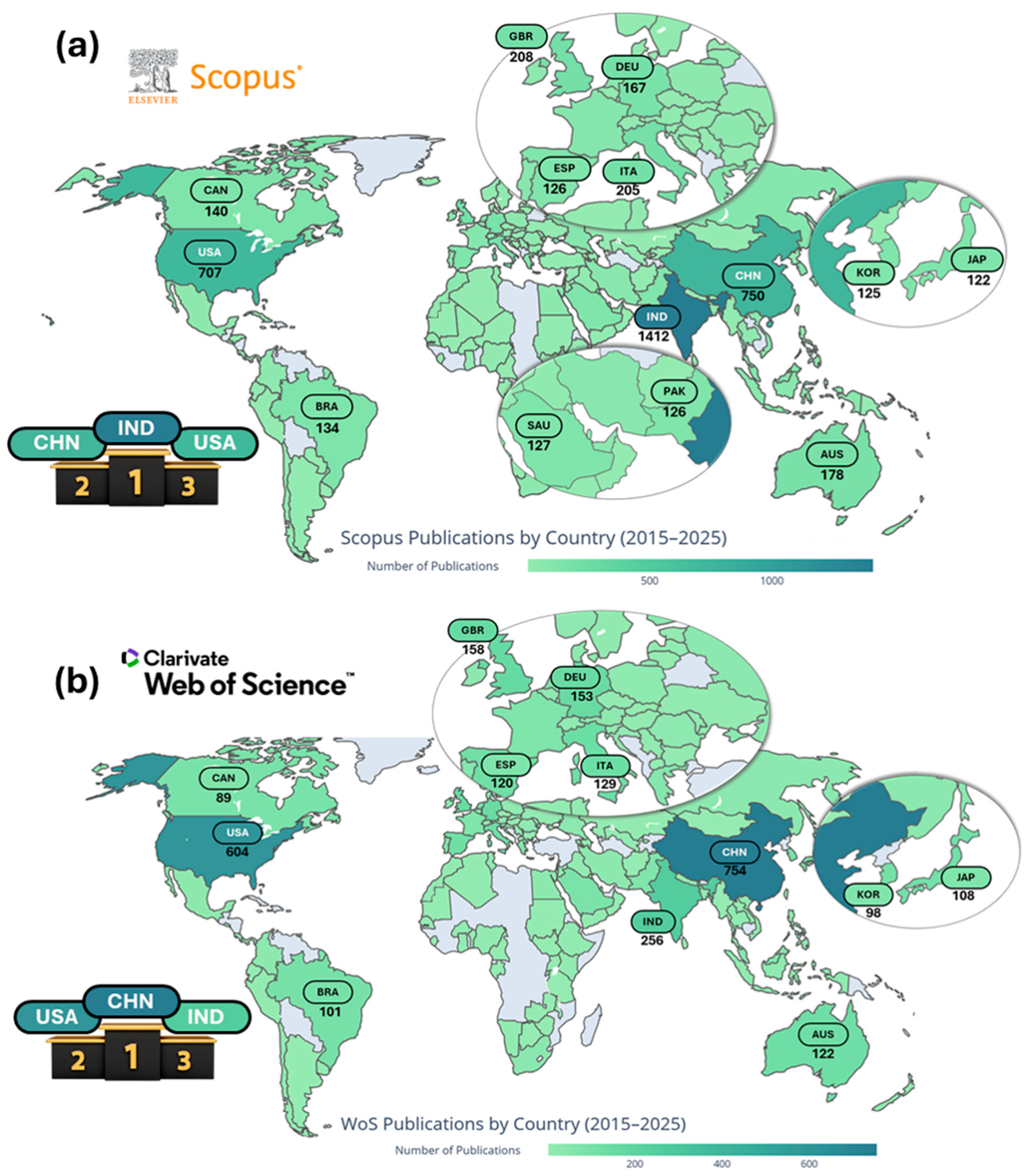
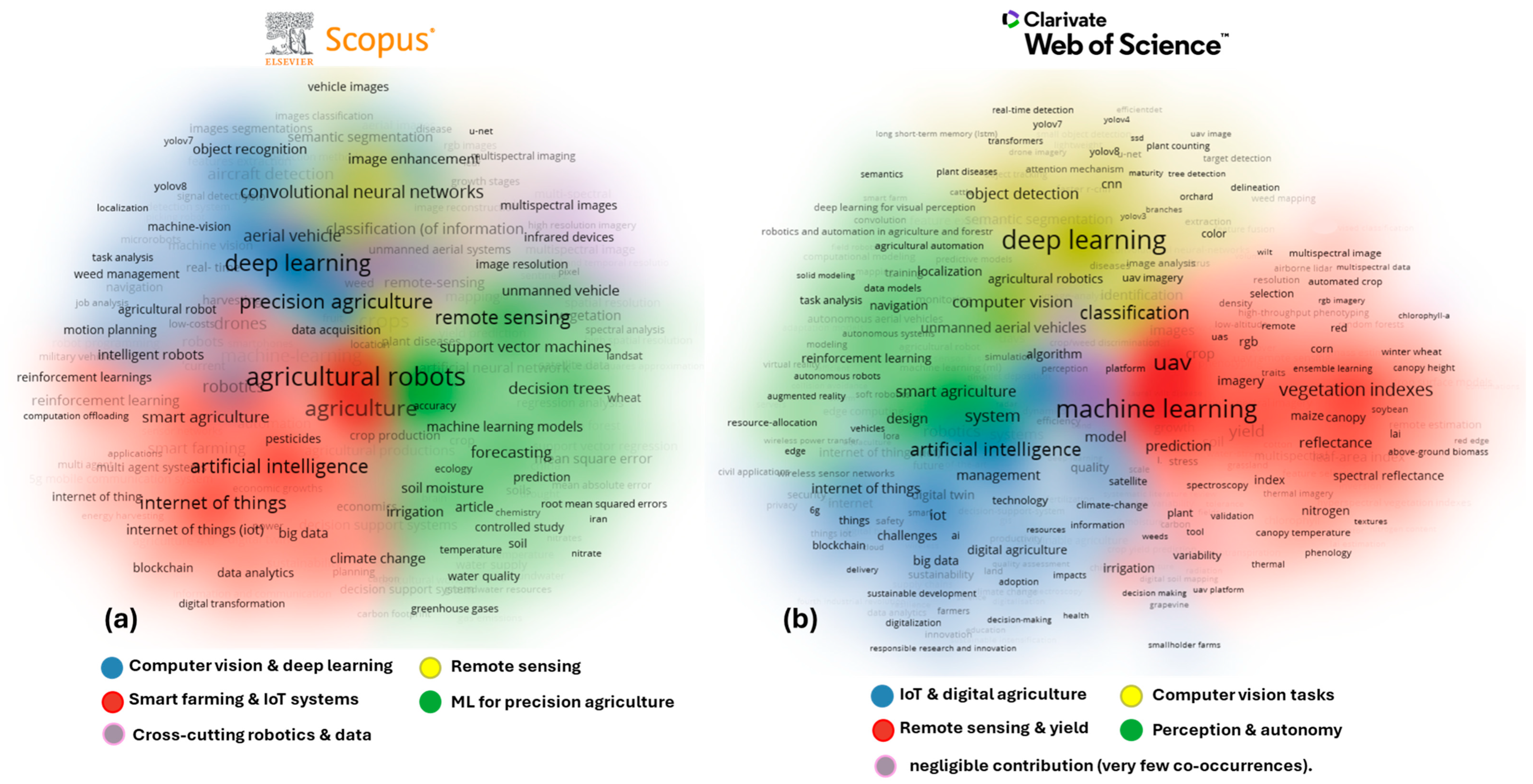
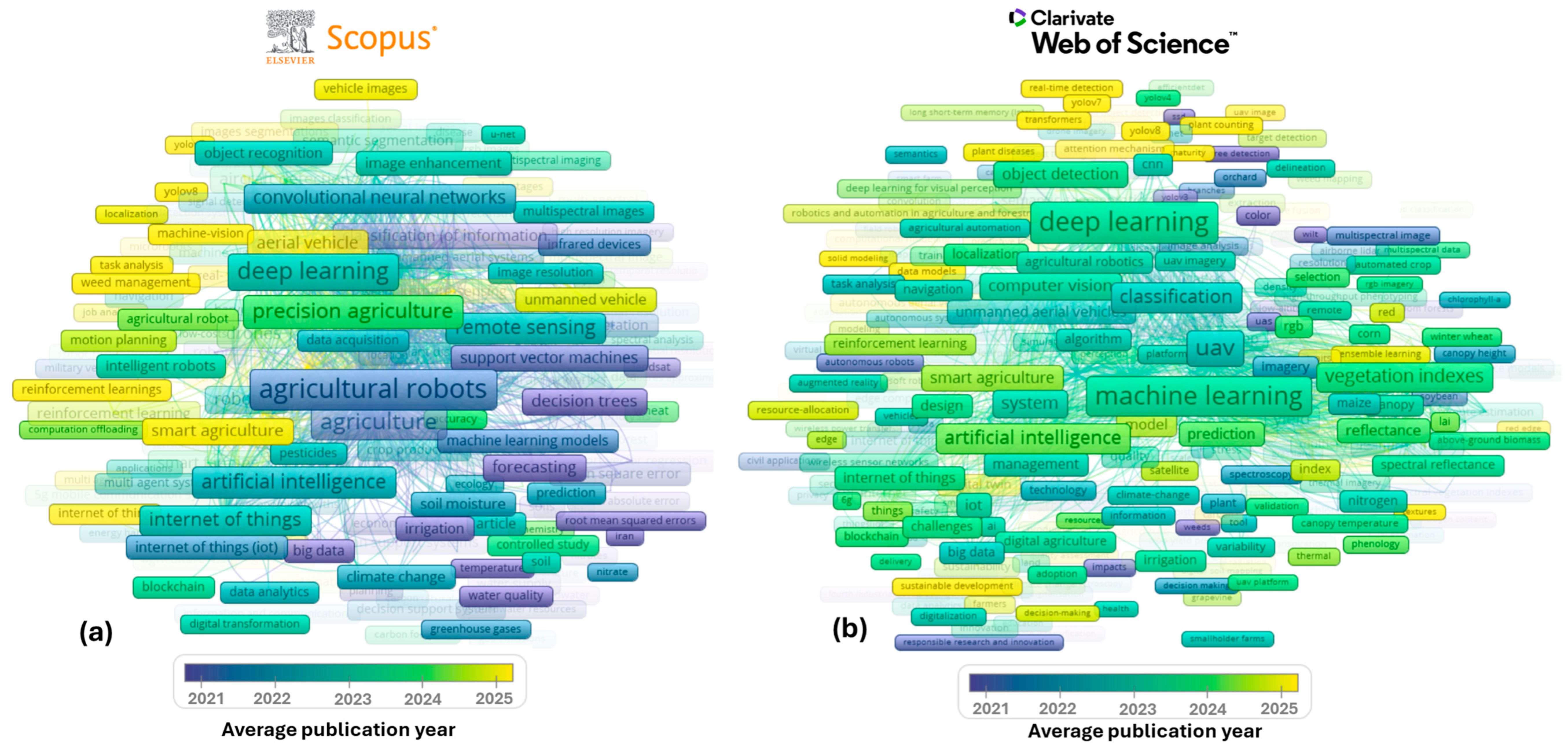
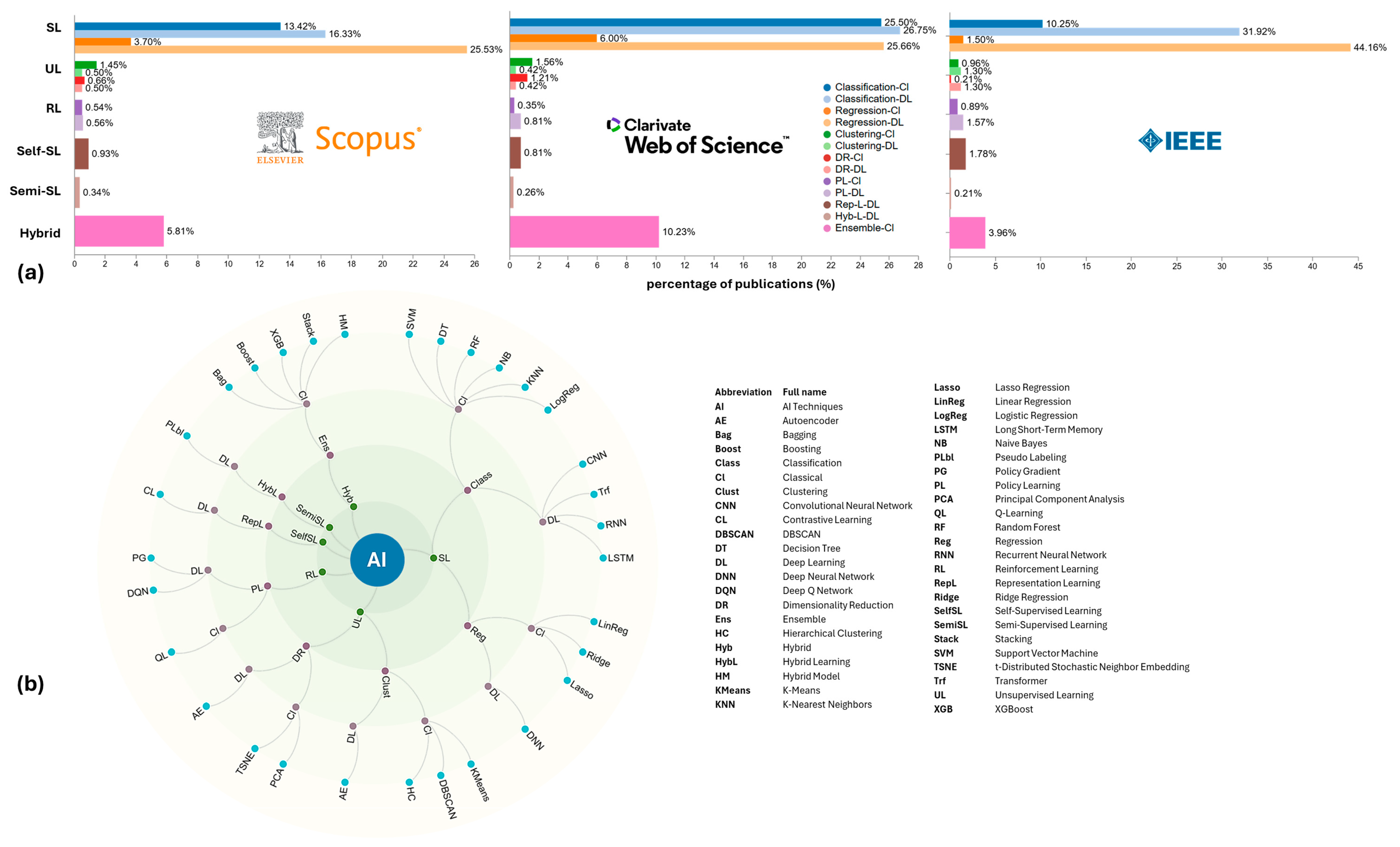
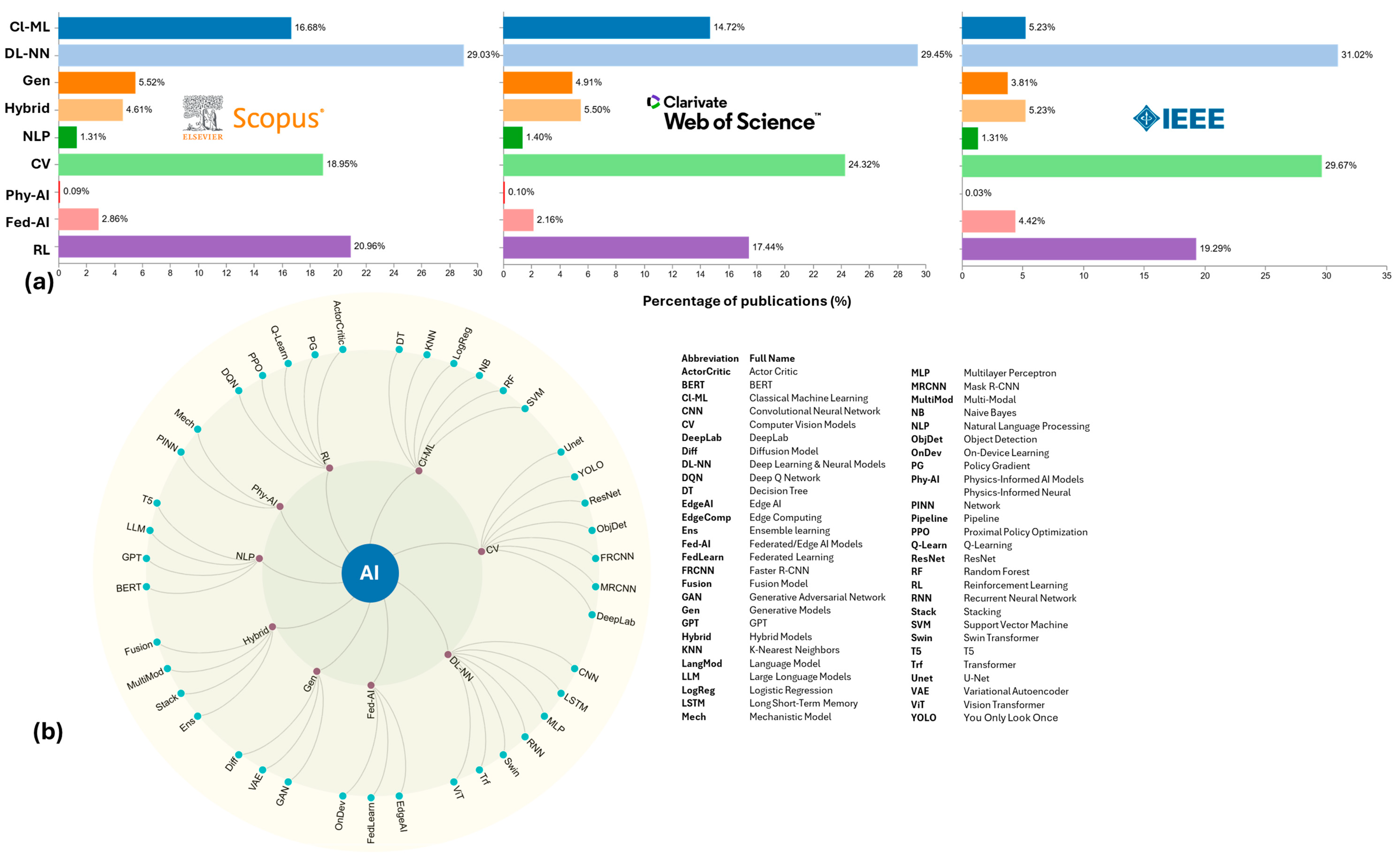



| Step | Description and Key Elements |
|---|---|
| Research questions | To guide the systematic review, we established key research questions focused on the intersection of AI and robotics in agriculture:
|
| Identification of keywords | We developed a comprehensive Boolean query to encapsulate the scope of the review: (“artificial intelligence” OR “AI” “machine learning” OR “deep learning” OR “zero-shot learning” OR “self-supervised learning” OR “reinforcement learning”) AND (“agriculture” OR “smart farming” OR “autonomous farm” OR “precision agriculture”) AND (“robotics” OR “agricultural robots” OR “swarm robotics” OR “UAV” OR “drone” OR “cobot” OR “multi-agent systems” OR “digital twin”) |
| Selection of resources | The literature search was conducted across leading academic databases relevant to AI, engineering, and agricultural science:
|
| Timeframe | The review includes peer-reviewed publications from 2015 to 2025, reflecting recent advances in smart agriculture and AI-enabled robotics. |
| Inclusion and exclusion criteria | Inclusion criteria:
|
| Article selection and screening | The search results were imported into Mendeley for deduplication. Final articles were selected based on full-text availability and relevance to the inclusion criteria. |
| Thematic analysis and synthesis | The included articles were categorized into thematic clusters such as robotic harvesting, precision irrigation, swarm robotics, and digital twins. Data extraction was conducted using a structured matrix to analyze methods, technologies, outcomes, and challenges. |
| Challenge Area | Key Gaps or Barriers | Future Research Opportunities |
|---|---|---|
| Field validation & robustness | Low real-field deployment rate; model fragility to outdoor conditions | Field-validated pipelines; domain adaptation; multimodal sensor fusion |
| Transparency & trust | Minimal XAI use; lack of interpretability | Saliency maps, LIME/SHAP integration; regulatory-aligned AI auditing tools |
| Regional & task imbalance | Underrepresented regions, crops, and tasks | Regional datasets; multi-crop training; task-diverse benchmarking frameworks |
| Energy & real-time constraints | AI too heavy for drones or embedded systems | Lightweight GAI model design; pruning/quantization; neuromorphic or analog AI |
| Social impact & equity | Labor replacement fears; high system cost; unclear data ownership | Fair-tech design; AI subsidy programs; open-source/localized AI; data governance |
| Scalability & infrastructure | Poor connectivity; lack of standards; hard to retrofit | Interoperable AI ecosystems; plug-and-play modules; federated learning frameworks |
| Limited coordination & autonomy | Few multi-agent or swarm systems | Swarm robotics; multi-agent reinforcement learning; cooperative planning algorithms |
| Climate-smart adaptation | Lack of focus on sustainable, regenerative practices | AI for carbon farming, biodiversity, water use optimization |
Disclaimer/Publisher’s Note: The statements, opinions and data contained in all publications are solely those of the individual author(s) and contributor(s) and not of MDPI and/or the editor(s). MDPI and/or the editor(s) disclaim responsibility for any injury to people or property resulting from any ideas, methods, instructions or products referred to in the content. |
© 2025 by the authors. Licensee MDPI, Basel, Switzerland. This article is an open access article distributed under the terms and conditions of the Creative Commons Attribution (CC BY) license (https://creativecommons.org/licenses/by/4.0/).
Share and Cite
Hamrani, A.; Allouhi, A.; Bouarab, F.Z.; Jayachandran, K. AI and Robotics in Agriculture: A Systematic and Quantitative Review of Research Trends (2015–2025). Crops 2025, 5, 75. https://doi.org/10.3390/crops5050075
Hamrani A, Allouhi A, Bouarab FZ, Jayachandran K. AI and Robotics in Agriculture: A Systematic and Quantitative Review of Research Trends (2015–2025). Crops. 2025; 5(5):75. https://doi.org/10.3390/crops5050075
Chicago/Turabian StyleHamrani, Abderrachid, Amin Allouhi, Fatma Zohra Bouarab, and Krish Jayachandran. 2025. "AI and Robotics in Agriculture: A Systematic and Quantitative Review of Research Trends (2015–2025)" Crops 5, no. 5: 75. https://doi.org/10.3390/crops5050075
APA StyleHamrani, A., Allouhi, A., Bouarab, F. Z., & Jayachandran, K. (2025). AI and Robotics in Agriculture: A Systematic and Quantitative Review of Research Trends (2015–2025). Crops, 5(5), 75. https://doi.org/10.3390/crops5050075








